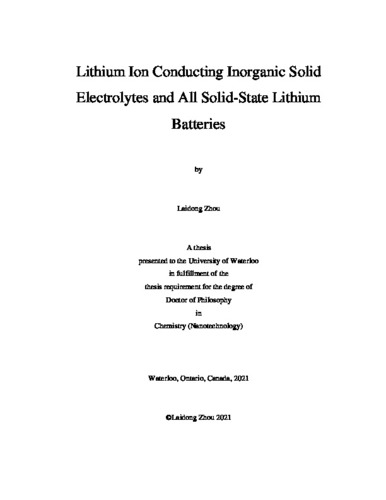| dc.description.abstract | As the world transitions away from fossil energy to green and renewable energy, electrochemical energy storage techniques, especially rechargeable batteries, increasingly become a vital component for this transition. High energy density lithium-ion batteries are currently the most popular candidates. Conventional lithium-ion batteries exploit flammable liquid electrolytes and carbon anodes that suffer from low energy density and safety risks. To meet the requirements for high energy density and high safety, rechargeable batteries based on the ‘beyond lithium ion’ technologies have been widely investigated. Among them, all solid-state lithium batteries that use a solid electrolyte in place of a liquid electrolyte - and ideally a Li metal anode - can eliminate safety concerns and provide higher energy density. Particularly, solid electrolytes are the vital component which can realize the potential of ASSBs. This thesis presents a thorough investigation on discovering new Li fast ion conductors (> 1 mS.cm-1) and understanding the fundamental structure-property relationships in ionic conductors and developing high energy density and long-lasting all solid-state lithium batteries and understanding the critical requirements for all solid-state lithium batteries operations.
Chapter 3 presents an entropically stabilized lithium fast ion conductor, Li3+xSixP1-xS4, with high ionic conductivity above 1 mS.cm-1. Using a combination of single crystal X-ray and powder neutron diffraction, the maximum entropy method, and impedance spectroscopy to explore the influence of aliovalent substitution in the thermodynamically unstable β-Li3PS4 lattice. Aliovalent substitution induces structural splitting of the localized Li sites, effectively stabilizing bulk β-Li3PS4 structure at room temperature and delocalizing lithium-ion density. The inherent entropic Li site disorder induced a frustrated energy landscape for Li ion diffusion, which leads to the highest ionic conductivity of 1.22 mS.cm-1 for the optimal material, Li3.25Si0.25P0.75S4, represents three orders of magnitude increase of ionic conductivity compared to bulk β-Li3PS4 and one order of magnitude higher than the nanoporous form. The significantly enhanced Li ion conduction and lowered activation barrier with increasing Li site disorder induced by aliovalent tuning represent an important strategy toward the design of new fast ion conductors.
Chapter 4 presents the first family of thioantimonate argyrodite lithium superionic conductors, Li6+xMxSb1-xS5I (M = Si, Ge, Sn). Exploration of the series using a combination of single crystal X-ray and synchrotron/neutron powder diffraction, combined with impedance spectroscopy, reveals that substitution induces negligible S2-/I- anion site disorder, but more importantly Li+ cation site disorder. The additional, delocalized Li ion density sits in new high energy lattice sites that serve as intermediate interstitial positions for Li ion diffusion. The corresponding coulombic repulsion force between Li ions, due to close distance ~ 1 Å, activate concerted ion migration, leading to a low activation energy of 0.25 eV. Superionic conductivity up to 24 mS.cm-1 is achieved - among one of the highest values reported to date. The new argyrodite SEs also demonstrate good compatibility with Li metal, sustaining over 1000 h of Li stripping/plating at current densities up to 0.6 mA.cm-2. The significantly enhanced Li ion conduction and lowered activation energy barrier with increasing Li cation site disorder reveals an important strategy toward the development of new superionic conductors (> 10 mS.cm-1).
Chapter 5 presents a new chloride fast ion conductor, Li2Sc2/3Cl4 with a disordered spinel structure, which exhibits an ionic conductivity of 1.5 mS.cm-1 and a low activation energy barrier 0.34 eV for Li ion diffusion. This material represents the first spinel-type chloride fast ion conductor. Powder neutron diffraction reveals a significantly disordered Li ion distribution over available tetrahedral and octahedral sites within the lattice, which forms an infinitely 3D connected Li ion diffusion pathway comprised of face-sharing octahedra and tetrahedra. Due to the intrinsic high oxidative stability of chloride materials, all solid-state batteries employing this new chloride solid electrolyte and typically high voltage cathodes (LiCoO2, LiNi0.6Mn0.2Co0.2O2 (NMC622) or high-Ni LiNi0.85Mn0.05Co0.1O2 (NMC85)) - without any coating - exhibit excellent electrochemical performance up to 4.6 V in terms of capacity retention and cycle life.
Chapter 6 presents a new lithium mixed-metal chlorospinel, Li2InxSc0.666-xCl4 (0 < x ≤ 0.666), with high ionic conductivity (up to 2.0 mS.cm-1) owing to a very disordered Li ion distribution and all solid-state batteries with exceptional electrochemical performance. All solid-state batteries using LiCoO2, NMC622, or NMC85 as cathode materials exhibit superior rate capability, extremely high discharge and areal capacities (> 4 mAh.cm-2, ~ 190 mAh.g-1), very high Coulombic efficiency close to 100%, and long-term cyclability - more than 3000 cycles - with 80 % capacity retention at room temperature (up to 4.8 V vs Li+/Li), surpassing the reported literature values for state-of-the-art all solid-state batteries. The excellent electrochemical performance originates from the superior interfacial stability between chloride solid electrolytes and un-coated high voltage cathode materials as revealed by impedance analysis and time-of-flight secondary ion mass spectrometry. This work provides valuable insight into the design and development of ASSBs and may serve as an important point of reference. | en |

